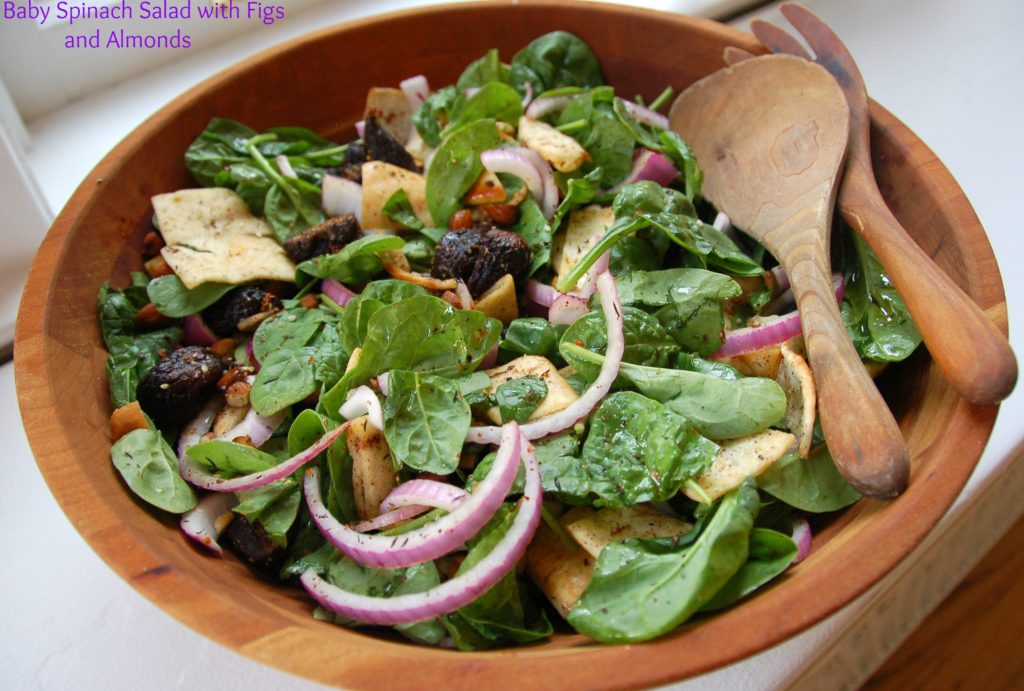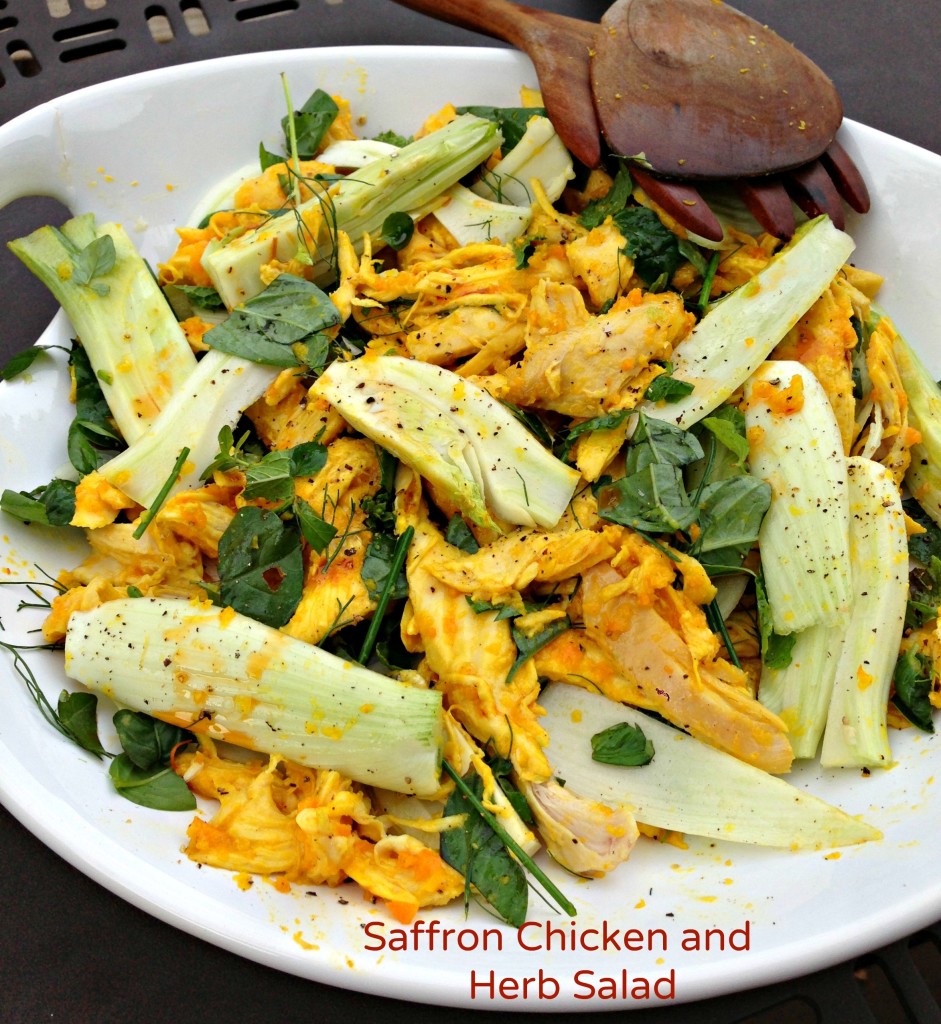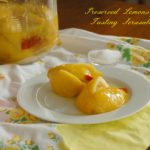It’s July and that means it is time for another Tasting Jerusalem topic. Created by two food writers, Beth from the blog OMG! Yummy and Sarene Wallace from 805 Living magazine, Tasting Jerusalem is a community dedicated to exploring the cuisine of the Middle East using the cookbook Jerusalem by Yotam Ottolenghi and Sami Tamimi as a guide. Each month, the organizers select a different ingredient or category of food featured in Jerusalem and ask the members to cook one or more of the recipes from the book that feature the chosen ingredient or kind of food. The participants then share their experiences on their blogs, on and on Twitter using the hash tag #TastingJrslm.
This month, our virtual cooking club is focused on salads and there are many unusual and creative salad recipes to chose from in Jerusalem. Interestingly, the authors do not devote an entire chapter of the cookbook to salads, but rather integrate salad recipes into categories like Vegetables, Beans & Grains, and even Meat. What this does, in my opinion, is emphasize how versatile and diverse Middle Eastern salads are, and how important cold, fresh dishes are to this cuisine. As Ottolenghi and Tamimi write in their introduction to the recipe for Na’ama’s Fattoush (p. 29):
Where you go in the city, at any time of day, a Jerusalemite is most likely to have a plate of freshly chopped vegetables — tomato, cucumber, and onion, dressed with olive oil and lemon juice — served next to whatever else they are having. It’s a local affliction, quite seriously. Friends visiting us in London always complain of feeling they ate “unhealthily” because there wasn’t a fresh salad served with every meal.
Throughout the book, Ottolenghi and Tamimi suggest recipe pairings for their salads based on the need to balance heavy dishes with lighter ones. Israel is a warm, lush place with bountiful crops, but many Jews emigrated there from cold places, like northern and eastern Europe. Their traditional cuisine — think brisket, stews and potato-based dishes — is heavy and better suited to that hardscrabble life of poor soil and long winters. I imagine that these people had to learn how to balance their traditional cuisine with the warm, arid climate in which they found themselves. Hence, the habit of pairing fresh salads with every meal. In the head notes to the recipe for Parsley and Barley Salad (p.81), for example, the authors write:
“Serious” Jerusalem dishes — those substantial, slow-cooked ones that everybody adores but at the same time is also slightly terrified of due to how heavy and sleep-inducing they can be — must always be accompanied by a sharp, fresh salad such as this one. The herbs and lemon juice cleanse the palate and give a certain sense of lightness, balancing out any overdose of carbs and unctuous meat.
The authors of Jerusalem also eschew the notion that salads are limited to one season, namely summer. They simply vary the ingredients of their salads based on what is in season. The recipe for Root Vegetable Slaw with Labneh (p. 49), for example, explains: “We make this salad in the winter or early spring, before any of the other summer crops are around.” And in the recipe for Roasted Cauliflower & Hazelnut Salad (p. 62), the authors write: “Cauliflower, raw or cooked, is a useful salad ingredient above all in winter when there aren’t a great variety of fresh vegetables available.” What a clever observation! I love cauliflower and make it a lot in the winter but I have never thought of making a salad with it. I usually roast it and serve it hot. But a room temperature cauliflower salad would be a nice change in the dead of winter, particularly as an accompaniment to a heavier dish. In short, the approach to the concept of salad in Jerusalem is refreshing — if you will forgive the pun — and liberating.
From the moment I bought this cookbook back in January, I have been working my way through these wonderful recipes that challenged my very notion of what constitutes a salad. Among the salad recipes I had made prior to the July challenge were Na’ama’s Fattoush (p. 29); Parsley & Barley Salad (p.81); Tabbouleh (p. 85); and Saffron Chicken & Herb Salad (p. 188). All were delicious.
I have made the Jerusalem Tabbouleh recipe practically weekly because I love it so much and because it is quick and easy. Bulgur wheat requires only a 5-minute soak in boiling water to be ready to mix with chopped parsley, mint and tomatoes. The Jerusalem version calls for a teaspoon of the spice mix Baharat, which contains allspice, and 2 teaspoons allspice; that is a little heavy on the allspice if you ask me. I barely season tabbouleh beyond salt and pepper myself, allowing the lemon juice and ingredients to shine. The Parsley & Barley Salad is another one I have made more than once. I love the combination of chewy, nutty barley, fresh parsley, creamy feta, and tart za’atar. I have substituted cucumber for the green pepper called for in the recipe with success since I don’t love green peppers.
I thought I would make a new salad recipe just for the July challenge and selected the Baby Spinach Salad with Dates & Almonds (p. 30) as the one to try. This salad combines baby spinach with spiced, toasted pita croutons and almonds which together give it some heft. It’s almost like your vegetable and starch in one dish. I served the salad alongside grilled, marinated chicken and together, they were a satisfying summer meal. The almonds and pita croutons are seasoned with sumac, which is quite tangy, and chile flakes to add some heat, so they contribute a lot of the salad’s flavor. With red onion and lemon juice in addition to the spicy almonds and pita, this salad has what Ottolenghi and Tamimi call ” a sharp freshness.”
While the recipe calls for pitted Medjool dates, presumably to add some sweetness, I opted to substitute dried figs for two reasons. First, dates freak me out. Yes, I admit it. To me, dates look like some kind of insect cocoon. My apologies if you are a date lover. So, given my squeamishness about dates, I never have them around. I did however have a beautiful bag of California Black Mission figs courtesy of California Figs. Halved, these sweet, juicy figs were a perfect complement to the salad’s piquant onion, spicy croutons and almonds, and tangy lemon juice dressing. Plus, their purple color popped against the green spinach and golden pitas. I think it was an inspired substitution.
Tasting Jerusalem is a virtual cooking community exploring the vibrant flavors and cuisine of the Middle East through the lens of “Jerusalem: A Cookbook” by Ottolenghi and Tamimi published by Ten Speed Press. You can follow along and cook with us by subscribing to omgyummy.com, following the hashtag #TastingJrslm on Twitter and Instagram, and liking our Facebook page.








Wow – Emily – this is such an informative post – if I wasn’t sitting in my office aka Starbucks waiting for the end of soccer practice, I’d be up and in the kitchen preparing salad. What a terrific overview of many of the books creative salad offerings. How did the figs do in the quick pickle with the onions? I just love that step in this salad – it’s so simple but adds just that extra punch. And I agree – it was an inspired substitution! Thanks for another great post.
Good question about how the figs fared in the 20-minute vinegar bath with the red onion. The vinegar definitely plumped the figs up a bit. I don’t know if it made them especially tangy.
Good question about how the figs fared in the quick vinegar bath with the onion. I expect the quick pickle had a similar effect on the figs as it would have on the dates: it plumps them up and adds a bit of tang.
Great post! Like how the authors challenged all our notions about salads. I’ve learned so much from this book and it sounds like you have too. BTW, love the fig swap for the dates. Perfect!